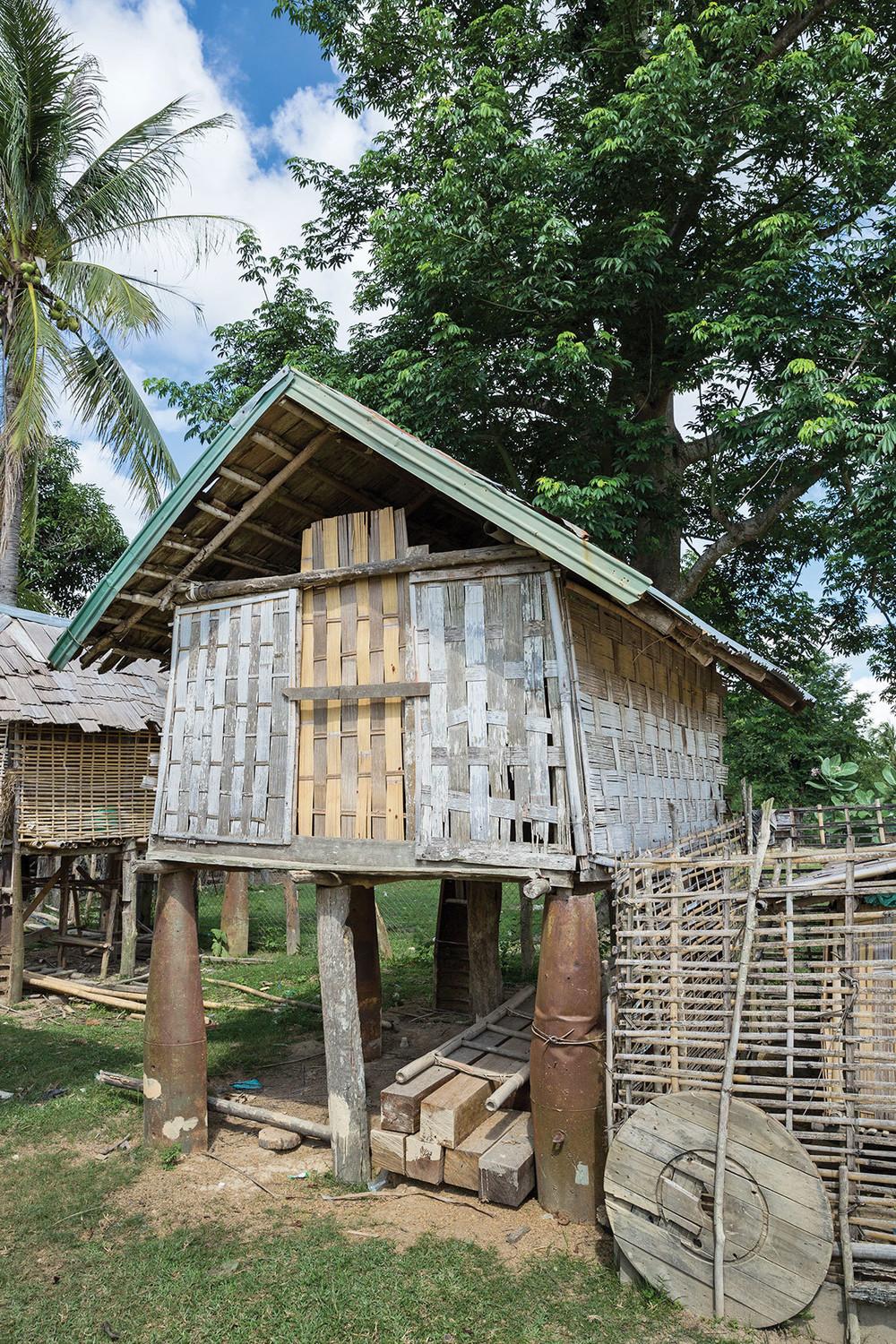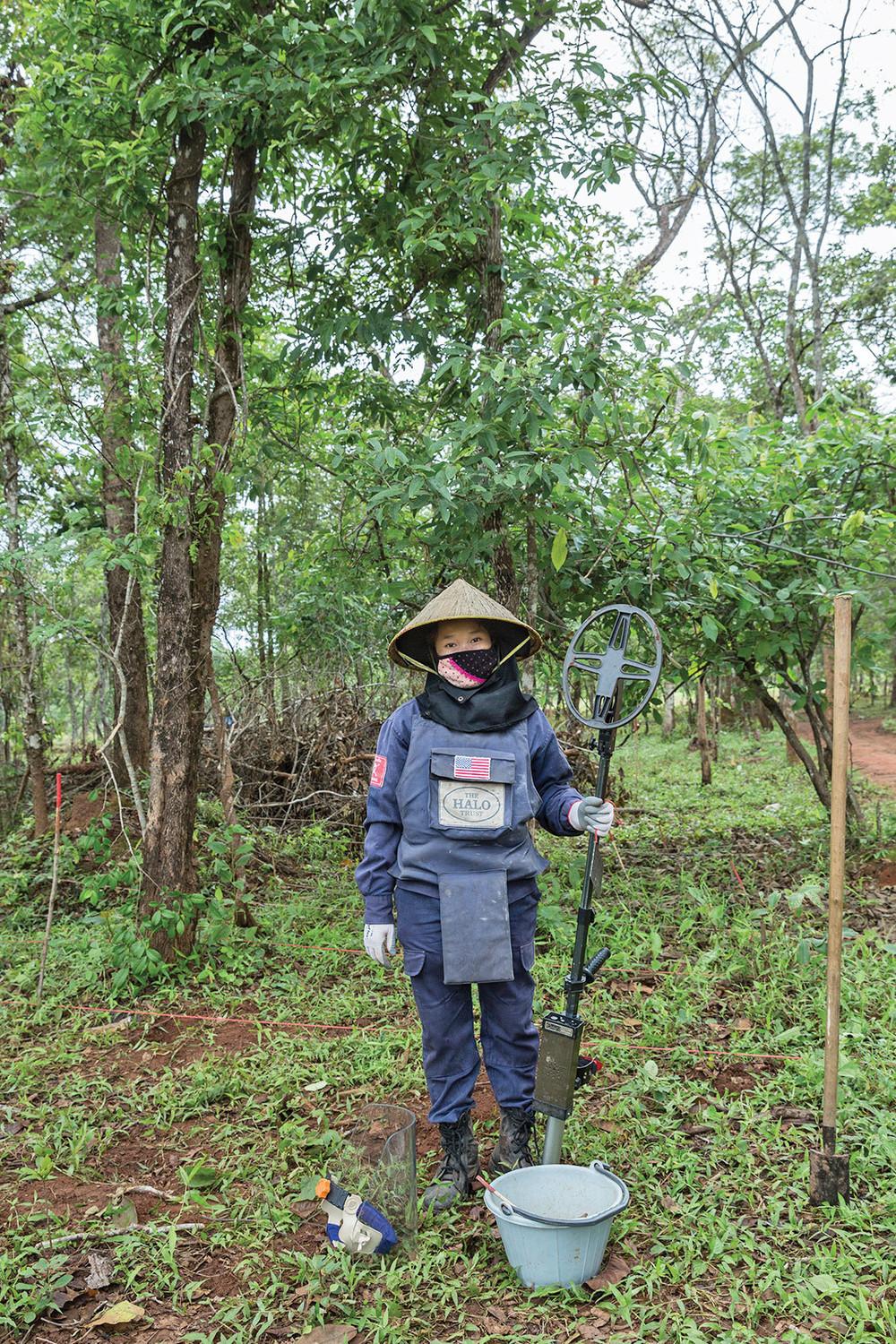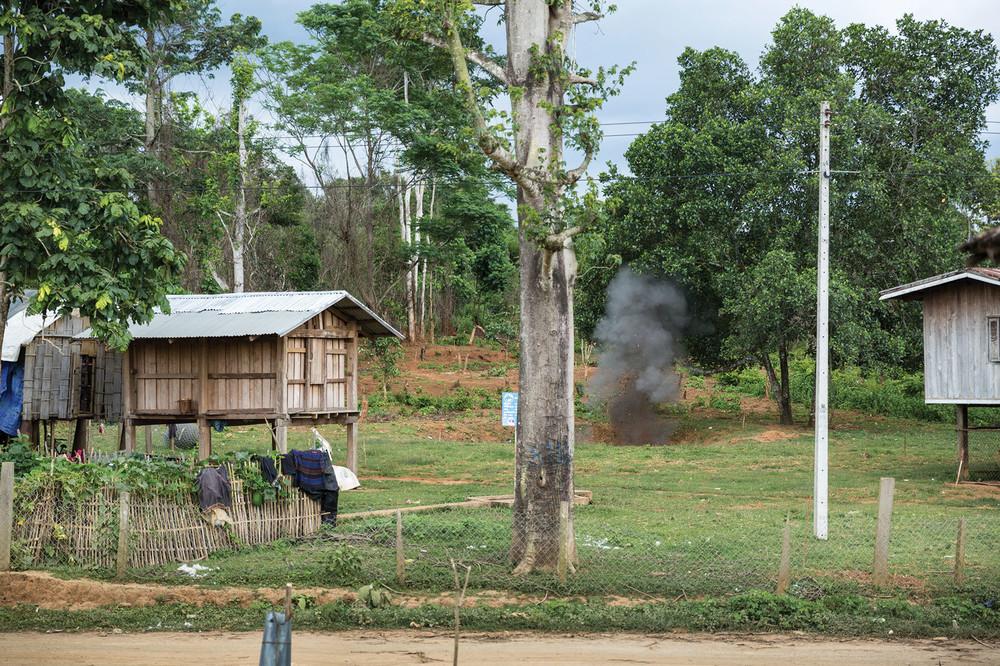This story appeared in the October issue of VICE magazine.
Last spring, deep in the rainforest-tangled limestone mountains of Laos’s Annamite Range, blasts from American cluster bombs ripped through the air as the jungle burned. A small, square-jawed, 66-year-old farmer named Somphone (some Lao farmers do not use surnames) had set the fire to clear his land for rice planting, then fled. Traditional slash-and-burn agricultural practices make every new rice season potentially lethal. The flora burns slowly—but deadly ball bearings, shot from Vietnam-era cluster bombs, fly fast. “I’m always nervous when I go to burn and when I plant,” Somphone said. “But I’m very careful.”
Videos by VICE
When the hockey-rink-size plot was cleared, Somphone saw seven or eight bomb craters punched deep into the earth by hundreds of pounds of American dynamite that had exploded 40 years earlier. Cluster bombs are different; they open aboveground, and a typical bomb, the CBU-24, ejects 665 bomblets, similar to hand grenades, which are engineered to wound and kill people with ball bearings. During the Vietnam War, the United States dropped 270 million cluster bomblets on Laos, and with failure rates estimated as high as 30 percent, up to 80 million live bomblets are still sprinkled across the country today.
As we sped down a gravel road in a HALO Trust–marked vehicle, an old man dressed in dark-green fatigues hailed frantically from the stoop of his hut. He cried, “La berd. La berd. La berd,” Lao for “bomb.”
Somphone scanned the soil for live “bombies,” as the Lao call the bomblets. At the bottom of a crater, he found one intact. Another lay caked in rust and soil beside a rock, and next to a burned log, one more was dug into the mud. Delicately, Somphone moved four live bombies to a rock crevice, where his family was less likely to step on them. He placed another in the notch of a stump and let the rest lie, undisturbed. (Bomb technicians say moving bomblets can potentially trigger their explosion.) Later, he collected the open shells of six spent bombies and added them to a scrap pile behind his hut. Lao farmers have scavenged American bombs and fuel tanks and put the metal to use to fashion pots and pans, fences, planters, and canoes. In Ka Toh Village, where Somphone lives, cluster-bomb canisters, with tags bearing the bombs’ origins – “DALLAS, TEXAS AND CAMDEN, ARKANSAS” – are used as stilts for villagers’ huts. The metal has also fueled a scrap trade, providing impoverished Lao a dangerous source of income.
A half-century ago, Ka Toh Village lay on the Ho Chi Minh Trail, a network of paths and roads carved through the Lao jungle by the North Vietnamese to skirt the well-fortified demilitarised zone in Vietnam proper and ferry crucial supplies, arms, and soldiers to the Communist insurgency in South Vietnam. To stem the flow of war material, from 1964 to 1973, American bombers poured 4 billion pounds of ordnance on Laos, with the majority landing on the Ho Chi Minh Trail, where a free-fire zone permitted indiscriminate bombing by America’s newest weapon: the B-52 bomber.

Many Lao people have collected bombshells to use as scrap metal or building materials for houses or structures, such as this grainstorage shed
During the war, Somphone and other villagers fled to a large cave in the mountains to escape the bombing. “When we returned, the trees were all gone – they’d been blown up,” he said and pointed down the dirt road that bisected the village. “All that was left were mud and craters. From here to far, far down the road, it was like this.”
Laos, neutral during the Vietnam War, now claims the ill fated title of the world’s most heavily bombed country on a per capita basis. Today, the jungle has returned, swallowing the scars of war and America’s unexploded ordnance (UXO). It remains dormant but deadly, and it has caused an estimated 20,000 casualties since the war’s end. “There are many bombs here,” Ton Keoduangdee, chief of Ka Toh Village, said. “Anywhere where people haven’t moved them, where people don’t go, you’ll find bombs.”
This month, President Obama will become the first sitting US president to visit Laos, a Communist country of 7 million people, wedged between Vietnam and Thailand. Obama is traveling to Vientiane, the country’s capital, far from the crushing poverty plaguing rural villages, some of which are so marred by bomb craters that they resemble the surface of the moon. Still, cleaning up the legacy of the Vietnam War was part of Obama’s agenda. In his final years in office, the administration has sought to repair relationships with countries that once felt the blunt end of American power. In Laos, the new engagement has translated into increased funding for UXO clearance and victim assistance, which averaged $3.2 million a year from 1995 to 2013. In 2015, the US State Department provided $15 million, and on September 6, Obama pledged $90 million for UXO-clearance funding over the next three years.
Although non-governmental organisations clearing UXO have operated in Laos since the 1990s, there is still much work to be done. In 2012, the State Department recruited the HALO Trust, an international mine-clearance operator, to the country and continues to fund its operations today. HALO’s local staff of 243 – Lao farmers, mothers, and young adults – have been trained as bomb technicians and are given cots in a rural tent camp with a starting wage of $330 a month, about triple the minimum wage.

Chaisouk Sisouvanna works as a medic and clearance technician for HALO Trust
As we sped down a gravel road in a HALO Trust–marked vehicle, an old man dressed in dark-green fatigues hailed frantically from the stoop of his hut. When we pulled to a stop, he rushed toward the car, his hands outstretched, cradling a black cloth bag. He cried, “La berd. La berd. La berd,” Lao for “bomb.” A yard from the car, the driver and translator shouted him to a halt. They demanded he put the bag on the ground, gently. Richard Bowyer, HALO Trust’s Laos operations manager, hesitantly stepped out to examine the contents. The old farmer pulled back the cloth folds, revealing a conical-shaped bomb.
“There are many of these on my land,” he reported. The next day, he led HALO staff to his plot, where six live cluster bomblets lay in the soil. The HALO team detonated them all.
Lapoukham Vilaiveng, a Lao woman of only four-foot-eight but with palpable authority, is a HALO team leader and often the person exploding the ordnance. She wears body armour, a plexiglass visor, and, on her right shoulder, a skull-and-bones patch above an American flag. She estimates she’s detonated more than 1,000 bombs. “It’s risky,” she said, “but you become immune to it.
“Ten years ago, my brother-in-law found a bombie. He played with it and blew himself up,” she explained. Her husband works on another HALO clearance team. “This is bigger than a job for us. It’s a moral responsibility.”
HALO divides its teams into survey and clearance work. All rise with the sun and don body armor and assemble metal detectors. Survey teams carry out a scan of an area to determine the perimeter of the UXO contamination – if there is one cluster bomblet, the theory goes, more are probably nearby. Clearance teams follow, sweeping every inch of soil and exploding every piece of UXO.
One afternoon, Vilaiveng weighed out C4-explosive material: 50 grams of the white clay for each BLU-26 bombie that a farmer had led her team to in the morning. She wrapped the C4-explosive clay in electrical tape and placed the C4 charge in a locked red toolbox for transport to the sparse jungle where the BLU-26 lay on a mound of semi-cleared rainforest. At the bomblet site, technicians prepared dirt bags to place over the bombie and then uncoiled fuse wire to a detonation point 150 yards away. Vilaiveng squatted to lay the C4 charge on top of the bomblet and pressed in the fuse wires. At the detonation point, she threaded the fuse wire into a trigger, and a man beside her counted into a walkie-talkie: “Three. Two. One.” The C4 detonated, catapulting dirt bags into the air and shredding them with ball bearings.
Cluster bomblets like those disposed of that day account for 71 percent of the 25,531 UXO items HALO Trust has cleared so far and have caused no less than one-third of Laos’s 826 causalities since 2008.
“Laos and Vietnam are quite unique,” said Susanna Smale, HALO’s Laos program manager. “There isn’t really this type of cluster-bomblet contamination anywhere else.” The Convention on Cluster Munitions, a treaty banning the use of cluster bombs because of the long-term residual toll they impose on civilians after a war’s end, has been signed by 119 nations. On June 30, France announced it had destroyed its stockpile of 15 million cluster bomblets. The US is not a party to the treaty, and according to Amnesty International, the American military most recently used cluster bombs in 2009 in Yemen. It has, however, committed to using cluster bombs with failure rates below 1 percent in the future.
For years, NGOs cleared areas in Laos after specific requests from residents, with only limited understanding about where Laos’s UXO contamination was most heavily concentrated. “It was clear if things continued on with the request-based clearance process, we’d keep on going and keep on going but still have those bombs everywhere,” Smale explained. When they realised a systematic approach would be more efficient, the first national baseline survey is due to begin in 2017 with State Department funding, in order to quantify the extent of Laos’s UXO contamination and identify areas for priority clearance. But like every project in this impoverished nation, finding the funds to complete the survey and clearance over the next six or seven years may be a problem.

HALO Trust regularly conducts controlled detonations when unexploded bombs are discovered. They’re often found in larger bomb craters left behind by previous explosions, sometimes in the middle of villages.
HALO Trust’s UXO-clearance work opens up new farmland for the Lao to cultivate. Yet, until recently, collecting and selling scrap metal from unexploded and exploded bombs provided the main source of cash income to farmers on the trail. American scrap metal made for better bartering than rice. But a steep drop in scrap-metal prices in Laos (to less than 20 percent of its peak), coupled with provincial laws banning the war-scrap trade, has left the Lao living on the trail worse off than they’ve been in years.
“No one comes to buy them anymore,” Sumta said of the exploded and unexploded bombs he once sold to Vietnamese scrap dealers. With money earned from the scrap trade, Sumta, 55, bought his family of six rice and food, and even built his tin-roofed hut, which teeters among the 66 bomb craters, some as large as 25 feet in diameter, that pockmark Kokmak Village.
Today his family’s sole income is the 30 to 50 bags of rice they harvest each year from their small plot of land. “It’s not enough to survive,” Sumta said. When I met him, he’d come from the rainforest with a slingshot in hand and a grin on his face. He’d shot a bird, he explained. When I asked to see it, his smile broadened, “I already ate it.” Hunger is still a nagging problem in the area, and the Lao scavenge the jungle for mushrooms and bamboo to eat and hunt birds with slingshots and muzzle-loaded rifles. A 2005 report commissioned by UNICEF and conducted by the Geneva International Centre for Humanitarian Demining found that in one of three surveyed districts 70 percent of families in the area collected and sold war scrap.
In the past ten years, the deadly consequences have been felt along the deteriorating dirt road that slithers into the jungle. At Kokmak Village, the scrap trade has claimed three lives. Three more villagers died in Gaang Village, four at Pakay Village, and, at Ka Toh Village, where Somphone farms among cluster bombs, UXO has claimed the lives of four children and two adults.
“We’d sell the metal or trade it for clothes, for food,” Somphone recalled. “We didn’t have enough food to eat.” In 2007, his eldest son, Koi, 37, found a bomb in the jungle and carried it home to dismantle and sell. It looked like a big bullet, and he hacked at the fuse with a machete. When it detonated, he and his hut exploded.
Ka Toh’s chief acknowledged that villagers desperate to sell metal caused four of the village’s six UXO deaths. “Back when the price was high, the whole village went hunting scrap, what else could we do?” he said. “We need the money.”
American bombs contaminate farmland and impede broader economic development. At a Chinese-owned iron mine on the trail, bombies have slowed production as they lace the iron ore. Construction of the Nam Theun 2, a hydroelectric dam in the area, required bomb clearance. So too did the planting of a eucalyptus plantation by a European paper company and the construction of Ka Toh’s schoolhouse. Every development project requires UXO clearance.
With few options to escape poverty, Lao farmers are waiting for Vietnamese scrap dealers’ carts and trucks to return to the trail. “When the metal price goes back up,” Ka Toh’s chief said with a laugh. “We’ll definitely get back to looking for the bomb scrap.”
This story appeared in the October issue of VICE magazine.
